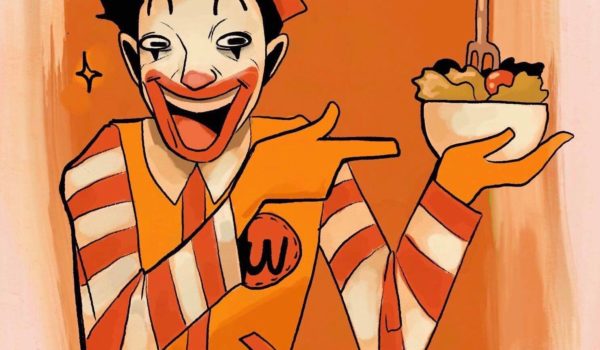This week, Morgan reviews Half-Life 2, in order to feel like he’s actually contributing to society.
I’m really about to stumble into the lion enclosure here, aren’t I? It’s a shame I didn’t do this review back before Christmas; it would have been the ideal way to thin out my social circle fast and not have to buy as many presents. Why? Because Valve’s Half-Life franchise is the Holy Scripture of the early 3D games industry: held in higher regard by some than their own mothers and with a following so passionately rabid, I’m likely to get crucified once I inevitably start widdling all over it.
The first Half-Life involved, to put it mildly, main character, physicist and The Original Mouthless Protagonist Jack-Off™ Gordon Freeman having a job that involves the performing of ever-nebulous “science” at the Black Mesa Research Facility. Of course, this being a videogame, things go wrong one day and his workplace is swiftly first-person shooter-fied with aliens and a violent military cover-up. Deciding to respond in kind, he guns down countless swathes of both, before being put under for a while by the mysterious “G-man” and waking up at the start of Half-Life 2 to find that said aliens have since taken over the entire Earth. Unbelievable. You nap for ten minutes and everything’s gone to shit. And to think that your biggest concern before this whole affair was Jerry from HR jamming the photocopier again.
It’s a fairly predictable sequence of events from then on: you join a group of resistance fighters so chuffed with the way you escaped that one science facility and… I don’t know, keep your beard trimmed so neatly, they let you join without a single instance of an employee screening process. I must say that this anti-establishment group must be low on morale-boosting figures if the best they can do is the guy who used a gun to clean up what was partially his own mess to begin with. He shot some military grunts, big whoop. One can only imagine how stale these people’s lives are for this to be a person you should lie down your life for, it makes the complete subjugation of humanity look like the highlight of their existence. I can kill soldiers and hide the bodies, but I’ve had no more than three blood sacrifices in my name, at the very least.
The implicit advantage of playing Half-Life 2 almost sixteen years after its release is that it helps me, a newcomer, see just how much it holds up by today’s standards without having to peer through the beer goggle-style filters of nostalgia. Source Engine, the software upon which the game runs, was cutting-edge at the time, so naturally they wanted to show it off every alternate step with physics puzzles and destructible objects. However, such instances tend to become a bit annoying after the first three hours or so. In this enlightened age of microtransactions and live-service bullshit, the things that may have once made our trousers tighten in satisfaction back then are frankly laughable now. You pile cinder blocks onto a see-saw, the see-saw tilts and allows you to use it as a ramp to reach a high ledge, and I guess that’s the point where I’m supposed to reach orgasm.
The issues with Half-Life 2 are little more than slight inconveniences, but they grow in number over time and end up leaving a little brown stain on the edge of the experience, i.e., an awkward weapon sound effect here, a noticeably flat texture there. I suppose this is inadvertently a good thing, in that it serves to show just how far game development has come over the last decade and a bit. But let’s not forget that more recent games have had subtle quality-of-life improvements, their absence now thrown into sharp contrast here. Having to crouch whilst jumping to get over a tall object, for example, is a fairly awkward workaround for a software limitation, and the Source Engine itself is getting a little crusty by now.
The reason I believe both Half-Life games stood out at the time is that they offer a very simplistic gameplay experience; the lack of cutscenes and the fact that the main character doesn’t talk means you can very well detach yourself from the story if you want to. The outdoor levels in Half-Life 2 are still particularly impressive, using cliffs to hide the edges of the map and areas such as beaches, roads and the sea to make it look larger than it actually is.
The gunplay is rather standard fare, just run around in circles and strafe every enemy to death. Except for one segment (and I hope the dry cleaners folded my latest batch of clothes neatly, as the grumpy trousers are coming on now), where I had to shoot a gunship from the top of a lighthouse with the help of an RPG. I say help, for the first half-hour or so the missiles would just fly off in the complete opposite direction like an under-stimulated Terrier I’d just made the mistake of shouting “walkies” too. At first, I put this down to the gunships wearing their rocket-repellent cologne they kept reserved for special occasions and bar mitzvahs, but after a Google search it turned out you had to guide the rockets in using the launcher’s laser pointer. After you’d fired them.
There are numerous moments like this, where concepts introduced over three chapters ago are brought up once and never again. It’s usually something physics-related (“Did we mention we’d made a brand-new engine? Just in case you missed it, we’ll show it off another five or six billion times!”), but it never fails to slam the brakes on the pacing, like an Asian Hornet getting in through your car window whilst you’re hurtling down the A19.
With the recent release of Half-Life: Alyx on Virtual Reality, the expense of the hardware meaning that maybe all of five people and their accountants can play it, you might appreciate a playthrough of Half-Life 2 as a time capsule. It seems that Valve won’t release a new instalment to the franchise unless it’s riding on the back of a technological breakthrough, so maybe in fifty years I’ll make another article on it whilst hooked up to the Matrix.









Comments